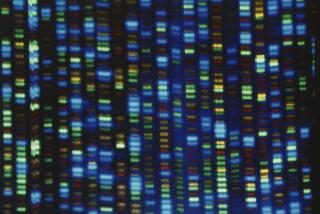Celera Delays Target Date for Genome Assembly
- Share via
Celera Genomics, the company competing with the public Human Genome Project to decipher the human genetic code, said Thursday that it expects to announce the assembly of its version of the human genome sometime in June.
That is somewhat later than J. Craig Venter, Celera president and chief scientific officer, told members of a congressional committee meeting in early April. At the time he announced that the company had finished the sequencing phase of its effort and would complete the assembly phase within three to six weeks.
That suggested a self-imposed deadline of mid-May for the completion of Celera’s human genome--about a month ahead of the expected public Human Genome Project’s date for finishing its “working draft” of the human genetic code.
However, in a news release describing the company’s participation in the annual Cold Spring Harbor genome meeting this week in New York, the company said it was “progressing on schedule” but noted that it “expects to announce the completion of assembly and validation phases of the human genome in June 2000.”
There was no explanation given for the apparent disparity in the dates. And company officials did not return calls.
The Rockville, Md.-based company and the public project have different approaches to deciphering the 3 billion chemical building blocks, or letters, that make up the human genetic code, or genome.
Celera scientists have broken multiple copies of the genetic code of a single, anonymous volunteer into millions of overlapping fragments of DNA, the molecule of human heredity. The team, using 300 high-speed automated sequencers, then determines the order of the chemical building blocks or letters in each of the small, overlapping pieces. On April 6, the company announced that it had completed the sequencing phase. But it still must assemble all the fragments in order to produce a completed draft of the genome--a huge task requiring a battery of supercomputers.
Researchers with the public project have taken a different approach, dividing up parts of each of the 24 human chromosomes among 16 centers around the world for mapping, sequencing and assembling.
Leaders of the public effort have said that they will finish a “working draft” by the end of spring.
Both sides in the competition have pointed out that their versions will be different from one another. And both will, for now at least, be incomplete; large sections of the human chromosomes cannot be sequenced with current technology.






